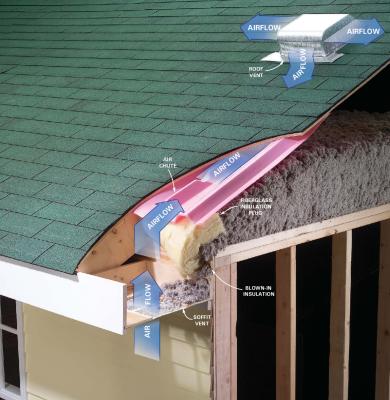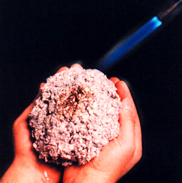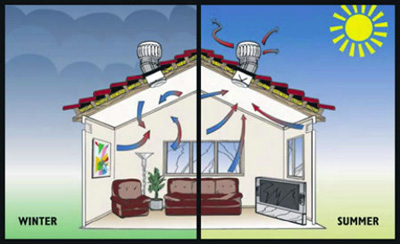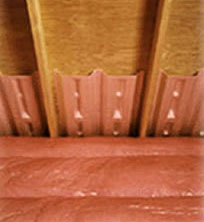
Services for Attic insulation
* Cellulose insulation
* Roof Vents
* Rafter vents
* Insulated hatch door with weatherstripping
Blown in Cellulose insulation
Cellulose is the oldest building insulation material. Many types of cellulosic materials have been used, including newspaper, cardboard, cotton, straw, sawdust, hemp and corncob. Monticello was insulated with a form of cellulose. Modern cellulose insulation, made with recycled newspaper using grinding and dust removing machines and adding a fire retardant, began in the 1950s and came into general use in Canada and US during the 1970s.
Recycled Content
Cellulose is composed of 75-85% recycled paper fiber, usually post-consumer waste newsprint. The other 15% is a fire retardant such as boric acid or ammonium sulphate. Cellulose has the highest recycled content of any insulation available. For example, fiberglass has a maximum amount of 30% recycled content. Low-Toxicity and Environmental Impact of Raw Materials
The non-recycled components of cellulose insulation are still environmentally preferable to the raw materials of most other insulation types, which are often petrochemical-based (this includes foam and fiberglass). Unlike foam insulations, many of which use HFC or HCFC blowing agents which have global warming potential hundred or thousands of times higher than that of carbon dioxide, cellulose does not produce significant gaseous emissions. Unlike fiberglass, cellulose does not use formaldehyde-based glues, which present a continuing hazard after installation due to off-gassing of formaldehyde.
Advantages of cellulose insulation
The thermal performance of loose filled cellulose compares favorably to other types of insulation. The thermal conductivity of loose-fill cellulose is approximately 40 mW/m·K (an R-value of 3.8 per inch) which is about the same as or slightly better than glass wool or rock wool. This doesn’t represent the whole picture of thermal performance. Other important aspects are how well the building envelope is sealed[clarification needed] from air infiltration, convective airflows, and thermal bridging.
Cellulose is very good at fitting around items in walls like pipes and wiring leaving few air pockets that can reduce the overall efficiency of the wall. Dense pack cellulose can seal walls from air infiltration while providing the density to limit convection, when installed properly. The University of Colorado School of Architecture and Planning did a study that compared two seemingly identical test structures, one with cellulose and the other with fiberglass. The cellulose structure had used 26.4% less energy to heat. It also was shown to tighten the structure more than 30%. Subsequent real world surveys have cellulose performing 20-30% better at reducing energy used for heating than fiberglass.
Cellulose’s insulation qualities “can save homeowners 20 to 50 percent on their utility bills”
The borates in cellulose insulation provide superior control against mold. Installations have shown that even several months of water-saturation and improper installation did not result in mold.
It is a common misconception that the mere presence of crude borates in cellulose insulation provides pest control properties to the product. While boric acid itself does kill self-grooming insects if ingested, it must be presented to an insect in both sufficient concentration and in an ingestible form in order to achieve insect fatality. Proper testing of products containing borates must be performed in order to determine whether dosage and presentation are sufficient to kill insects. Once tested, registration with the EPA as a pesticide is required before a product may be touted as having pesticidal capabilities.
 Fire Retardation
Fire Retardation
The borate treatment also gives cellulose the highest (Class I) fire safety rating. Many cellulose companies use a blend of ammonium sulfate and borate. Although ammonium sulfate is normally odorless, unexplained emission of ammonia and a resulting ammonia smell has been found in some cases.
Vapor Barrier
A vapor barrier may not be needed with cellulose insulation. For example, recent studies have shown that air movement is the primary method by which excessive moisture can accumulate in mild marine climate. An insulation that fills the wall cavity completely (such as cellulose or foam) can help prevent moisture problems. Recommendations against using vapor barriers with cellulose insulation are supported by studies, even though they classify cellulose as vapor permeable.
In addition, cellulose acts to distribute moisture throughout the cavity, preventing the buildup of moisture in one area and helping to dry the moisture more quickly. Cellulose manufacturers do not recommend the installation of a vapor barrier with cellulose.
Roof vents:

Attic ventilation is an important part of roofing. Proper attic ventilation extends the life of a roof and reduces problems because it minimizes the temperature differential between the attic and the air outside. Proper ventilation will remove moisture and heat from the attic. Trapped heat and moisture can raise energy costs, cause ice dams, and damage roof system components as well as structural and personal items located inside the attic where temperatures can easily reach 150° F (65° C).
Here are some problems associated with an improperly ventilated attic space
* In colder climates – generally where the average January temperature is 32° F (0° C) or colder – high inside humidity (40% or greater) combined with low outside temperatures can cause frost to form on the bottom of the roof deck. See Dry Rot in the glossary.
* Insulation can trap moisture which will reduce the R-value of the insulation and create a nice environment for the propagation of certain molds, spores, and fungi which will also cause problems.
* There is also the problem of mildew which is both damaging and can cause health problems.
* The roof system itself will deteriorate prematurely.
* Ice Dams – ice dams are the result of melting snow continually refreezing at the roof perimeter and then backing up under the shingles and causing leaks. Proper ventilation used in conjunction with heavy insulation and an air barrier can create a Cold Roof Assembly which will help eliminate ice dams.
 Rafter vents:
Rafter vents:
Installation of rafter vents (also called insulation baffles) will ensure that you get the best performance from your insulation. Rafter vents ensure the soffit vents are clear and there is a channel for outside air to move into the attic at the soffits and out through the gable or ridge vent. Rafter vents are placed in your attic ceiling in between the rafters at the point where your attic ceiling meets your attic floor. Once they are in place, blown cellulose insulation can be installed.
Attic Access:
Attic hatch (scuttle hole) , Knee-wall door
The attic hatch, or scuttle hole, is a removable panel in the drywalled ceiling or wall. Typically insulated with rigid foam board or fiberglass batt insulation R40 is recommended, installed weatherstripping provides a tight seal.